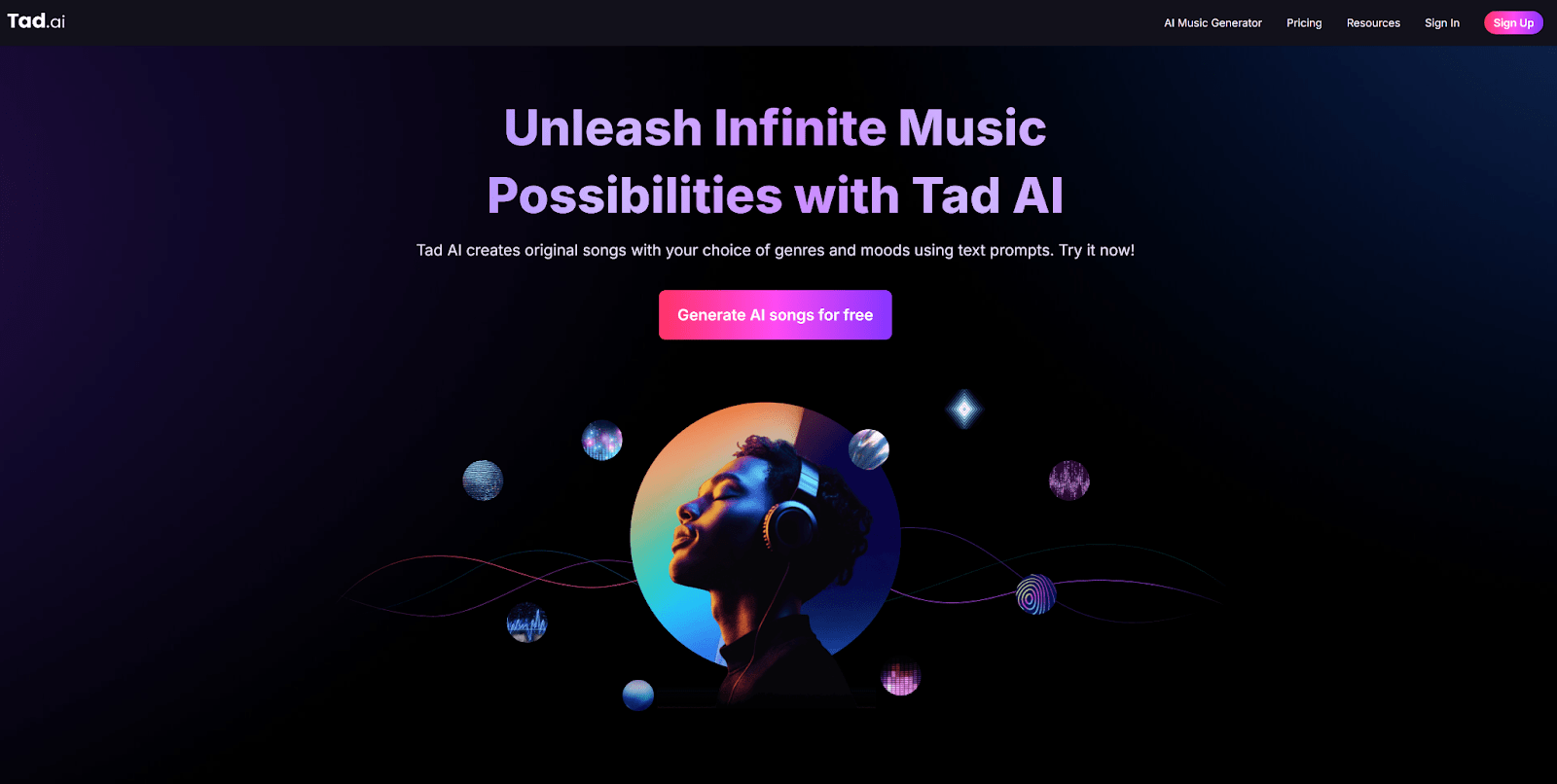Tad AI isn’t just another AI tool in the market — it’s a dedicated music-generation platform designed specifically for video content. While most royalty-free libraries rely on static catalogs and generic tunes, Tad AI uses AI-generated compositions to produce dynamic, tailored soundtracks from text prompts in real time. For content creators, marketers, educators, and brands seeking fast, unique, and license-safe music options, Tad AI offers a streamlined solution that fits directly into video production workflows.
This review breaks down the key aspects of Tad AI — how it functions, what makes it stand out, where it fits best, and what drawbacks still exist.
What Is Tad AI?

Tad AI is an online AI music generator that converts natural language prompts into full-length audio tracks. Instead of browsing endless music libraries for something “close enough,” creators can describe the mood or theme they want — “uplifting electronic for a tech product demo,” or “lo-fi chill for a travel vlog” — and get a fully rendered music file in seconds.
Because Tad AI is browser-based, there’s no need to install or download anything. All generation, playback, and export features happen online, making it ideal for creators who work across devices or collaborate remotely.
How It Works
Text-Prompted Music Generation
The user interface is centered around text input and dropdown selections. Users input a song title or theme, select from genre categories like cinematic, electronic, acoustic, rock, or lo-fi, and then choose a mood such as dreamy, tense, upbeat, or ambient. The AI then synthesizes a unique track that matches those parameters.
The generated track isn’t just a loop or generic beat — it comes with a clear intro, buildup, progression, and resolution. This structure makes it instantly usable in longer-form content like YouTube videos or presentations.
Output Format and Download
Each track is downloadable in MP3 format, and Tad AI includes metadata such as genre, mood, and licensing type. Filenames are automatically labeled using a consistent naming convention, making them easy to sort inside editing software or asset management systems.
Tracks are ready for use in editing programs such as Adobe Premiere, Final Cut Pro, or DaVinci Resolve. There’s no need to convert or tweak formats before import.
Audio Quality and Composition Depth
Tad AI’s engine, powered by the Skymusic 2.0 model, creates tracks that reflect real musical arrangements, not just randomized loops or synth-heavy filler. The compositions include balanced instrumentation, stereo panning, and compression that align with typical video post-production requirements. Elements such as basslines, percussion, melodic leads, and ambiance are layered in a way that supports narrative pacing rather than competing with it.
In practical use, the quality falls somewhere between mid-tier stock music and custom scoring. It’s not on the same level as a full DAW production done by a composer, but for the majority of content creators, it’s more than sufficient for professional output.
Licensing and Commercial Use
Music licensing is a make-or-break topic for video producers. Tad AI’s licensing model is clean and creator-friendly. Tracks generated under paid plans are royalty-free, meaning users can publish, monetize, and distribute video content without fear of takedown notices or copyright flags.
The free plan provides a limited number of tracks and is restricted to non-commercial use, giving users the opportunity to test the platform’s capabilities before upgrading.
This setup is especially beneficial for creators publishing on platforms like YouTube, Instagram, TikTok, and LinkedIn, where automated content ID systems can otherwise flag or demonetize background music.
Who Should Use Tad AI?

1. Content Creators and Vloggers
Daily vloggers, tech reviewers, or lifestyle creators benefit from Tad AI’s ability to maintain consistent audio branding. Instead of recycling public domain tracks or spending hours searching royalty-free libraries, they can generate intros, outros, and background loops that feel unique to their content and update them regularly to stay fresh.
2. Brands and Agencies
Marketing and creative teams working on video ads, product videos, or brand storytelling can use Tad AI to produce music that aligns with their visual tone and brand voice. The platform enables quick iteration — ideal for meeting deadlines or pitching multiple concepts without hiring a composer for each version.
3. Social Media Managers
For creators on TikTok, Reels, or Shorts, Tad AI provides short, dynamic tracks that align with current trends. With the right mood and genre selections, it’s easy to generate catchy snippets that complement viral content or enhance motion graphics.
4. Educators and Course Builders
Educational content requires soundtracks that enhance engagement but don’t distract from narration. Tad AI’s ambient and cinematic modes allow course creators to add polish to videos, lectures, or animations while keeping the focus on information delivery.
Advanced Features
Lyric Generation
Tad AI also includes a lyric-generation tool, which can produce simple lines or chorus phrases based on the same input prompts. Though it’s not a songwriting powerhouse, it’s useful for branded intros, karaoke overlays, or videos that need a vocal hook for audience recall.
Automated Mastering
Every track generated goes through an automatic mastering process that normalizes loudness and adjusts frequencies based on common streaming and publishing standards. For creators who don’t have an audio engineering background, this is a valuable time-saver. Outputs typically conform to LUFS standards used by YouTube and Spotify, meaning fewer manual tweaks in post.
Limitations
Despite its strengths, Tad AI isn’t without caveats.
- Lack of Deep Editing: Users can’t download stems or MIDI data. Once a track is generated, it’s a finished product. If you want to isolate instruments, make tempo adjustments, or rearrange sections, you’ll need external tools.
- Basic Lyric Depth: The lyric generation tool is limited in complexity. It works for short, punchy lines, but it’s not intended for full songwriting use cases.
- Credit Limitations: Heavy users may run out of track-generation credits quickly and need to upgrade to higher-tier subscriptions. Depending on your production schedule, this could become a recurring cost.
- Mastering Variability: While automated mastering does a decent job, tracks might still require subtle EQ or compression tweaks to sit perfectly within a busy mix.
Final Thoughts
Tad AI offers a compelling alternative to both stock libraries and expensive custom music production. Its ability to create custom-fit tracks from a simple prompt saves time, reduces cost, and minimizes licensing headaches. For video creators working under tight timelines and limited budgets, it delivers fast, good-enough audio that enhances storytelling and production value.
Is it for everyone? No. If you need full DAW control or hyper-specific music cues, it won’t replace human composers or advanced software. But for most content creators producing frequent video content, Tad AI is a practical, accessible way to keep their soundtracks original and legally safe.
For video workflows that demand speed, simplicity, and licensing clarity, Tad AI stands out as a solid AI-powered tool with real value.
⸻ Author Bio ⸻
Kelly is a tech enthusiast and AI programmer with a keen interest in machine learning, software development, and data science. She regularly contributes to tech blogs and online publications, sharing insights on AI advancements and coding best practices. In her spare time, Kelly enjoys experimenting with new programming languages, attending tech conferences, and exploring the latest trends in artificial intelligence.











